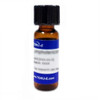Voriconazole is a synthetic, second-generation, broad-spectrum triazole antifungal. It is a derivative of fluconazole with increased antifungal activity and specificity. It inhibits ergosterol synthesis, which is the major sterol in fungal cell membranes. The compound is used in the treatment of a broad spectrum of yeasts (including Candida) and molds (including Aspergillus). Voriconazole was patented in 1990 by Pfizer.
Voriconazole is sparingly soluble in ethanol and DMSO.
| Mechanism of Action | The mechanism of action of the azole family is to inhibit cytochrome P450 (specifically CYP450-dependent 14-alpha-sterol demethylase) which depletes ergosterol in fungal cell membranes. This increases cell permeability and disrupts normal cellular function. |
| Spectrum | Voriconazole is fungistatic against all Candida species, including fluconazole-resistant strains of C. albicans. It is fungicidal against molds including many Aspergillus species. |
| Microbiology Applications | Voriconazole is used as a control and ERG11 inhibitor in YPD medium. It can also be used to test its interactions with valproic acid (VPA) during VPA-synergy assessment (Chaillot et al, 2017). |
| Insect Biology Applications | Voriconazole can be used in an invertebrate in vitro model with Galleria mellonella (greater wax moth) larva. It is an alternative animal model for studying antifungal efficacy on mycosis, including cryptococcosis. Using 12 Cryptococcus neoformans and C. gattii strains to assess capsule thickness, biofilm formation, survival, and morbidity. The compound was found to reduce fungal burden and dissemination in the larval tissue (de Castro et al, 2019). |
| Molecular Formula | C16H14F3N5O |
| References |
Beredaki M et al (2019) Voriconazole efficacy against Candida glabrata and Candida krusei: Preclinical data using a validated in vitro pharmacokinetic/pharmacodynamic model. J. Antimicrob. Chemother. 75(1):140-148 (Epub) PMID 31665417 Chaillot J et al (2017) pH-Dependant antifungal activity of Valproic acid against the human fungal pathogen Candida albicans. Frontiers in Microbiol. 8(1956):1-10 PMID 29062309 de Castro SC et al (2019) Efficacy of Voriconazole in vitro and in invertebrate model of cryptococcosis. Arch Microbiol. doi: 10.1007 (epub) PMID 31832690 Johnson LB and Kauffman CA (2003). Voriconazole: A new triazole antifungal agent. Clin. Infect. Dis. 36(5): 630-637 Lei j, Wu J and Wang T (2018) In vitro susceptibility of Candida spp. to fluconazole, itraconazole and voriconazole and the correlation between triazoles susceptibility:Results from a five-year study. J. Mycol. Med. 28(2):310-313. Richie DL et al (2013) Identification and evaluation of novel acetolactate synthase inhibitors as antifungal agents. Antimicrob. Agents Chemother. 57(5):2272-2280 PMID 23478965 Siopi M et al (2014) Susceptibility breakpoints and target values for therapeutic drug monitoring of Voriconazole and Aspergillus fumigatus in an in vitro pharmacokinetic/pharmacodynamic model. J. Antimicrob. Chemother. 69(6):1611-1619 PMID 24550381 Scott LJ and Simpson D (2007) Voriconazole: A review of its use in the management of invasive fungal infections. Drugs 67(2):269-298 PMID 17284090 |


